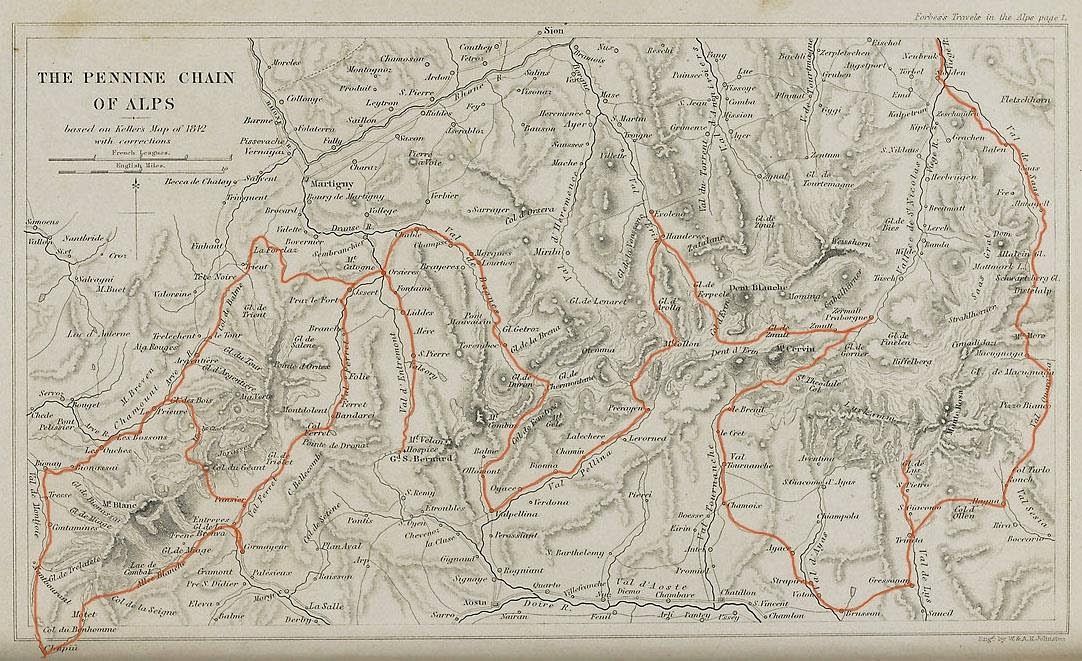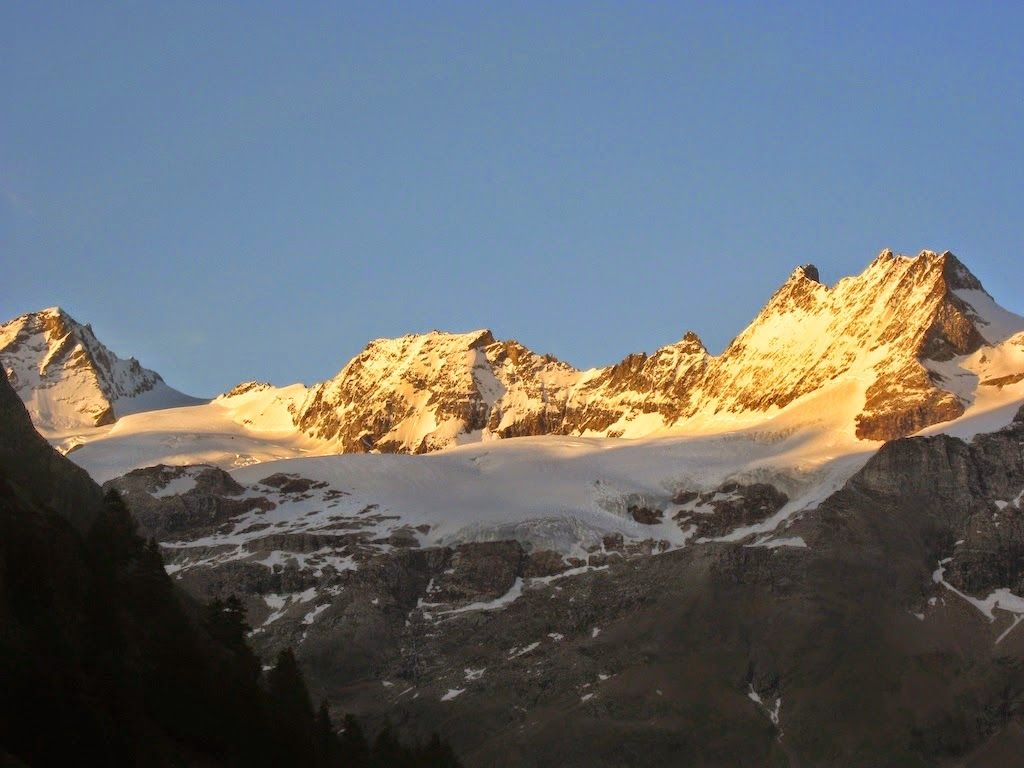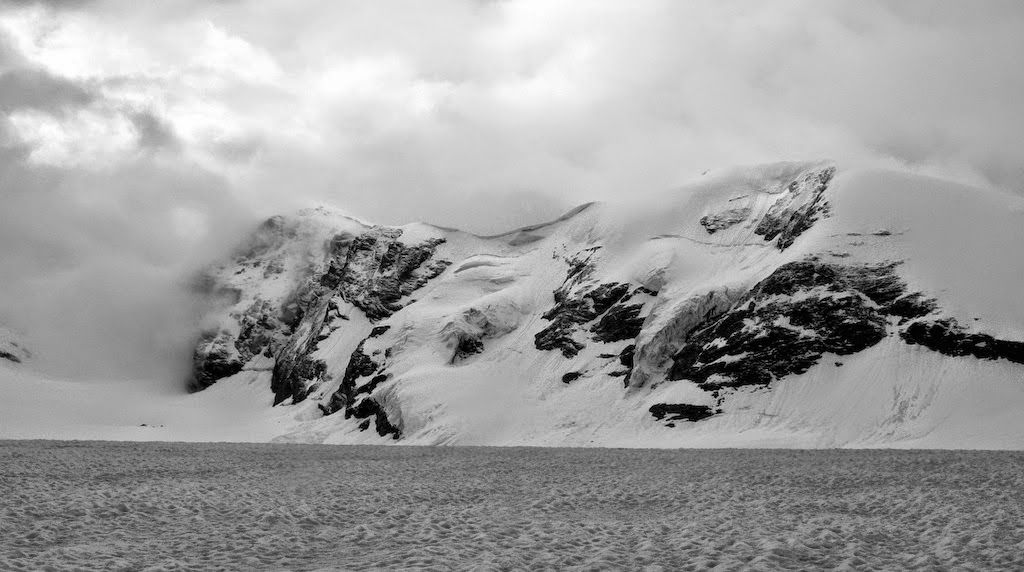The Grand Route Forbes — a long-distance hike in the Alps

Regular followers of this blog will be aware that I admire the writings of James Forbes, a Scottish geologist best known for his pioneering studies on the glaciers of the Alps. I have written before about the long foot journey he conducted in 1842, and I’ve even followed the central portion of this route myself.
It turns out that his wanderings of 1842 can be adapted into a truly superb long-distance Alpine trail.
I’ve been picking at the idea for a couple of years. While reading his book, I plotted the approximate route on the map Forbes used to explore the Alps (a variation on Keller’s map, which is very inaccurate). I have not yet plotted all of the route on modern maps to any degree of detail, but I’ve seen enough to realise that this is potentially one of the best long-distance hiking routes in this part of the Alps.
 |
| Forbes’s wanderings, plotted on his map of 1842. |
Adapting the original route
It’s important to realise that Forbes was a nomadic scientist, not a backpacker. Consequently his journey was planned with certain specific objectives in mind, and also the practicalities of travel at a time before the Alps were developed for tourism. He mainly stayed in inns and friendly houses, so sometimes he was forced to make detours towards centres of population. He covered the same ground more than once on several occasions and made one particularly lengthy out-and-back detour to the Great St Bernard Pass.
There’s also technical difficulty to consider, and the fact that the glaciers of the Alps have changed considerably since 1842. For example, the traverse of the Col du Geant and Mer de Glace from Courmayeur to Chamonix is a very different proposition in the early 21st century. Following this section of his route would require covering most of the Tour du Mont Blanc twice.
 |
| View from Prayayer Alp, above the Valpelline |
It’s therefore necessary to adapt Forbes’s 1842 route if we want to turn it into a modern trail. The purpose of a journey like this today would, after all, be to enjoy a beautiful long walk in the Alps — it would certainly not be to slavishly copy a historical journey, although I believe there is much enjoyment to be had in emulating Forbes’s voyage in spirit.
The modern Grand Route Forbes
My adapted “Grand Route Forbes” follows the majority of the original route, with a couple of omissions and modifications. I believe it takes the traveller through some of the finest landscapes in the Alps. Here’s a quick mockup on a Google Maps screenshot:

The first portion of the voyage follows the Tour du Mont Blanc from Chamonix to Courmayeur, then up Val Ferret. Instead of heading back towards Chamonix, it passes through Orsieres and enters the Val de Bagnes, crossing the Fenêtre de Durand to Valpelline. The walker then follows the length of Valpelline before crossing the Col Collon and Arolla Glacier to Evolene. From Evolene — which makes a natural midpoint of the route — the glacier pass over the Col d’Herens takes the traveller to Zermatt (this is the most difficult section, and the only leg that will certainly require full glacier travel gear and the experience to use it).
From Zermatt, the hiker then embarks upon a variation of the Tour of Monte Rosa — a superb high-level route circumnavigating that great mountain massif via a number of high cols, and visiting several tributary valleys of the Valle d’Aosta. I have modified this portion of the route to avoid a needless diversion to the village of Chamois. The Theodul Glacier pass takes the walker from Zermatt to Champoluc, Gressoney, Alagna, Macugnaga, and over the Monte Moro pass to Saas Grund. Finally, the stunning Balfrin Höhenweg conveys you along the length of the Saastal to Stalden and finally Visp, where Forbes concluded his journey.
Distance, timings, and practicalities
 |
| Oyace, in the Valpelline. Beautiful walking country! |
I have not calculated the full length of the Grand Route Forbes, but I estimate it — very roughly — to be between three and four hundred miles. Although it crosses many wild and high cols, it also visits numerous centres of population and is almost certainly possible to complete without having to wild camp or sleep rough, if that’s the hike you want to hike. The voyage can be broadly viewed as a variation on three existing long-distance paths: the Tour du Mont Blanc, part of the Haute Route, and the Tour of Monte Rosa. There are numerous facilities along the way. If you have the money to spend, you can probably stay in mountain huts or hotels most nights.
This is not a mountaineering expedition, but some of the cols are high and glaciated. Notably, the route crosses the Col Collon, Col d’Herens, and Theodul Glacier. The first and last of these are not difficult and might be passable without glacier equipment by experienced walkers in good conditions, but the Col d’Herens is a technical, crevassed portion and it would be highly unwise to cross this without a rope and the necessary equipment. Walkers without a background in alpinism will probably need to hire a guide for this section.
The majority of the other cols along the way are below 3,000m, and during the summer season should be passable with standard walking gear. However, weather in the Alps can be fickle and it can snow any day of the year at these altitudes, turning an easy path into a much more difficult proposition. It’s also likely that snow will lie on many of the higher areas well into July. The Tour du Mont Blanc, which largely forms the first portion of the route, can be viewed as a gentle introduction to the more difficult sections beyond. This is not a route for a novice walker.
My Grand Route Forbes journey
 |
| Mont Brule, from the Col Collon pass to Arolla. |
I don’t have a month or two to thru-hike the route in its entirety, but I have already walked the central section (Valpelline — Evolene) and intend to complete the entire route in instalments over the next few years. I relish the challenge of taking on my next planned section in September: the Tour of Monte Rosa.
It’s a real pleasure to follow in the footsteps of one of my heroes from the history of Alpine exploration, seeing the same sights that Forbes saw, and reading his beautiful descriptions. When I hiked the Valpelline — Evolene section last year, I found the comparison between the landscape in 1842 and the modern era extremely interesting. It really hit home just how much the Alps have changed since then. The glaciers are, sadly, mere shadows of what they once were.
When I walk each section of the Grand Route, I will do so with Forbes’s book in hand and my eyes open, trying to see the Alps as he saw them — and recording my thoughts on the changes that have taken place. It’s going to be an incredible adventure, and if it takes me years to do it then it will be even more worthwhile in the end.
I am keen to hear from walkers who have already completed this route, or maybe even decide they would like to try it for themselves after reading this introduction. Please get in touch!
Alex Roddie Newsletter
Subscribe here to receive my occasional personal newsletter in your inbox. (For the fun stuff, please consider subscribing to Alpenglow Journal instead!)



